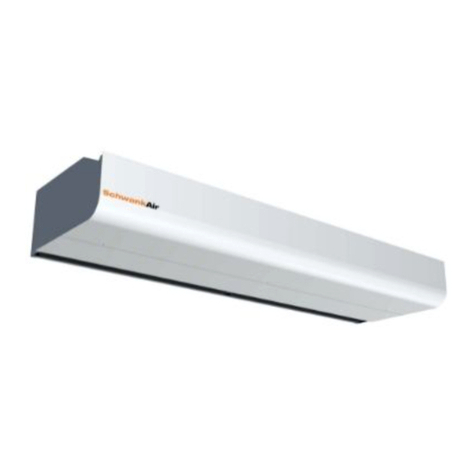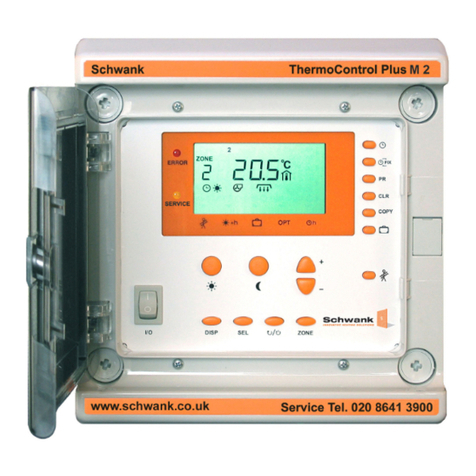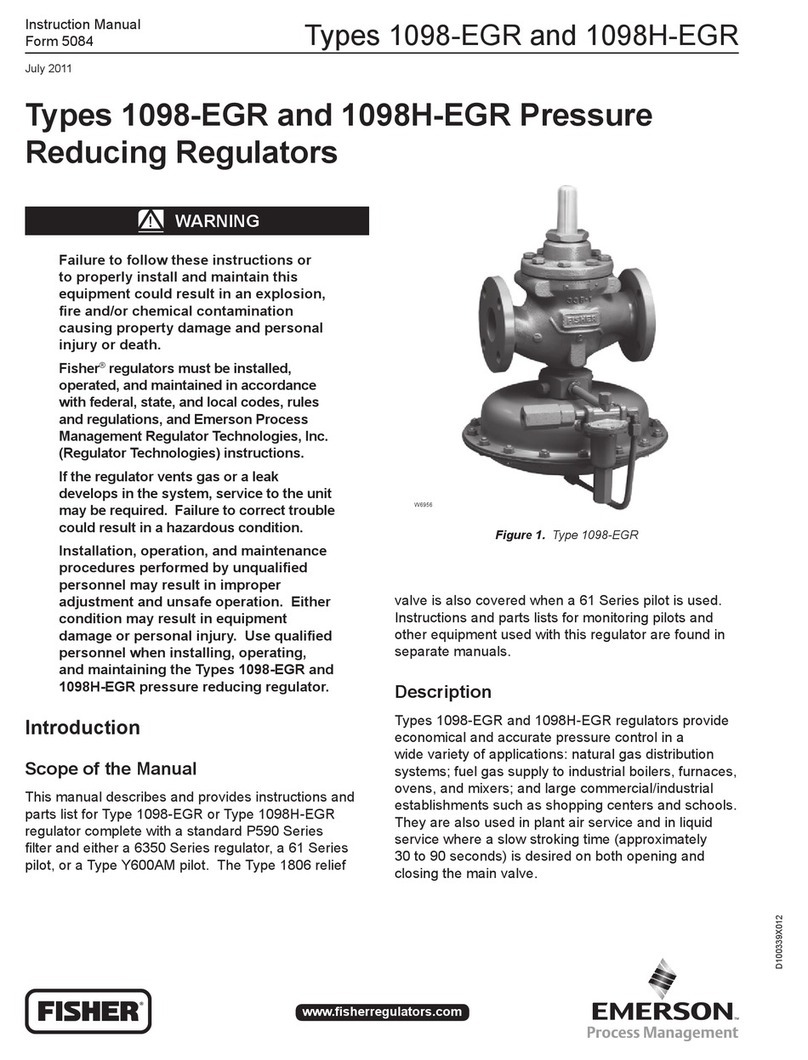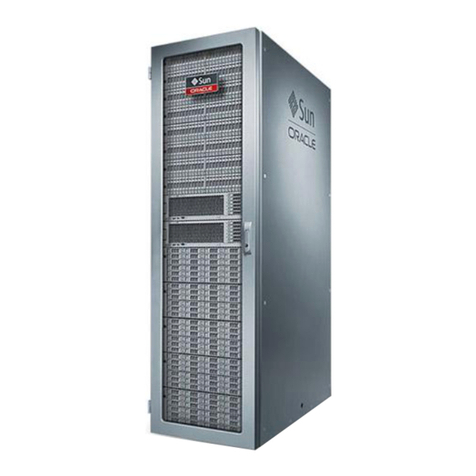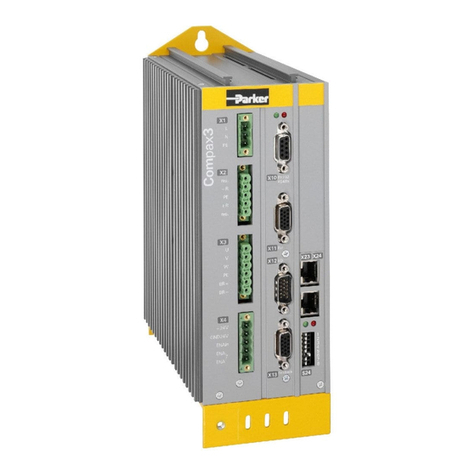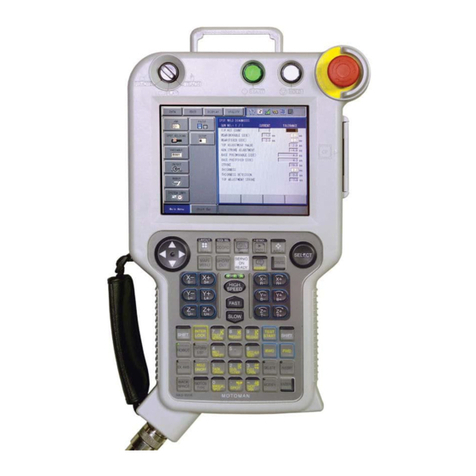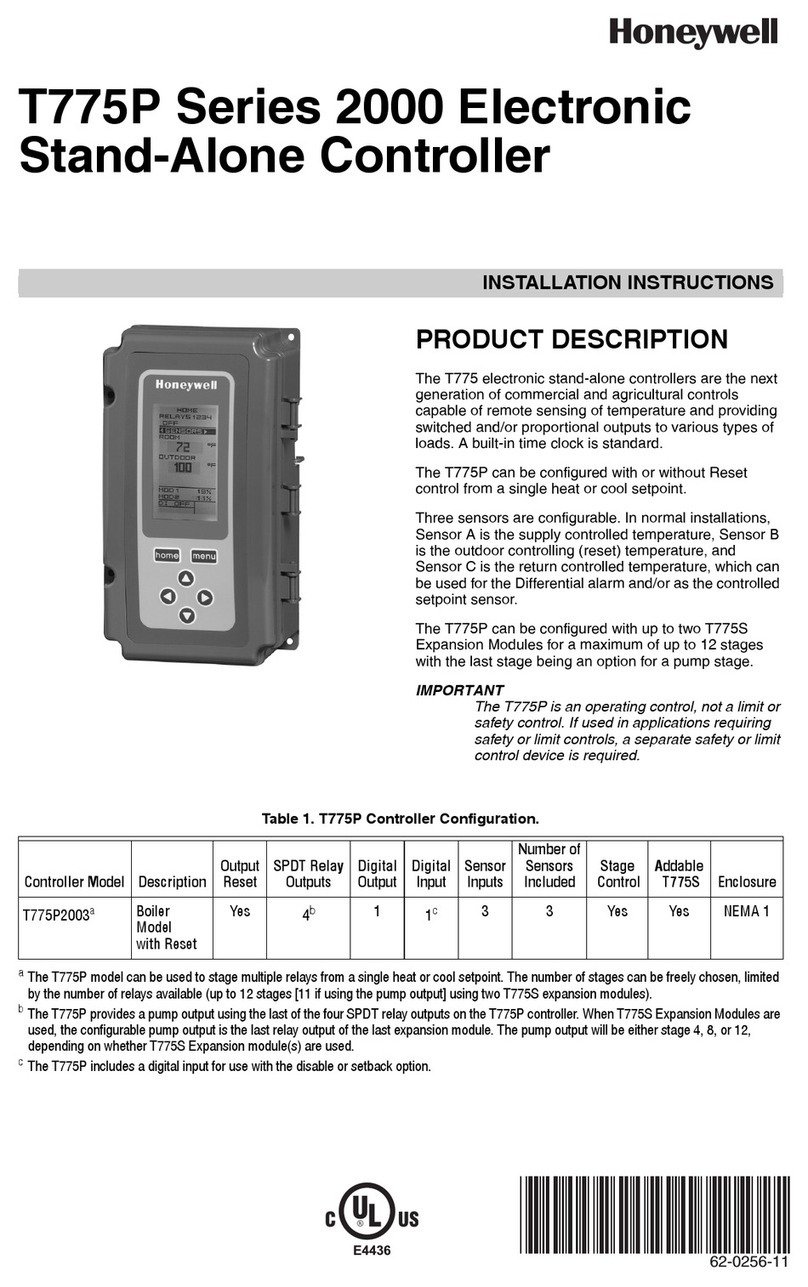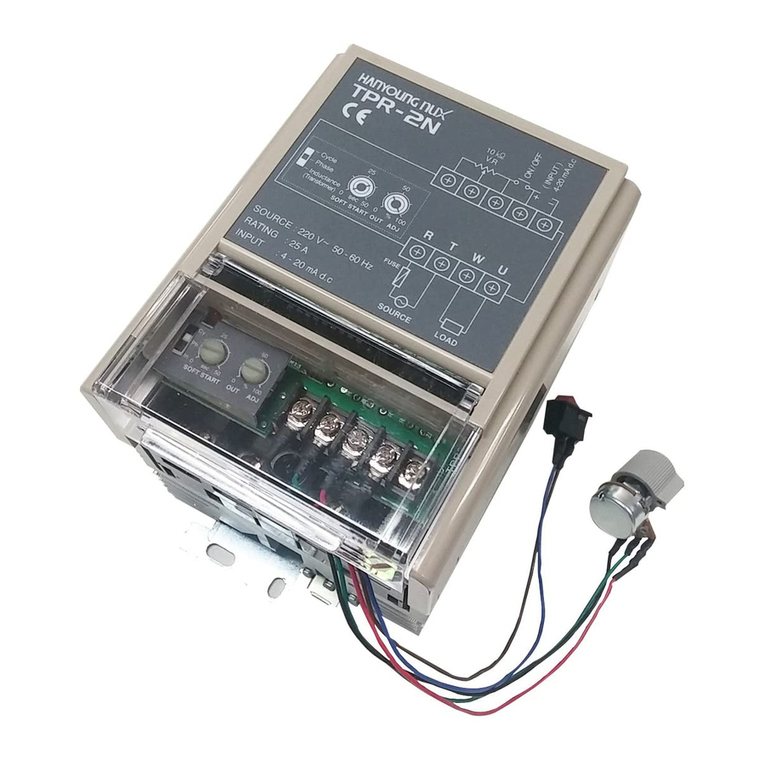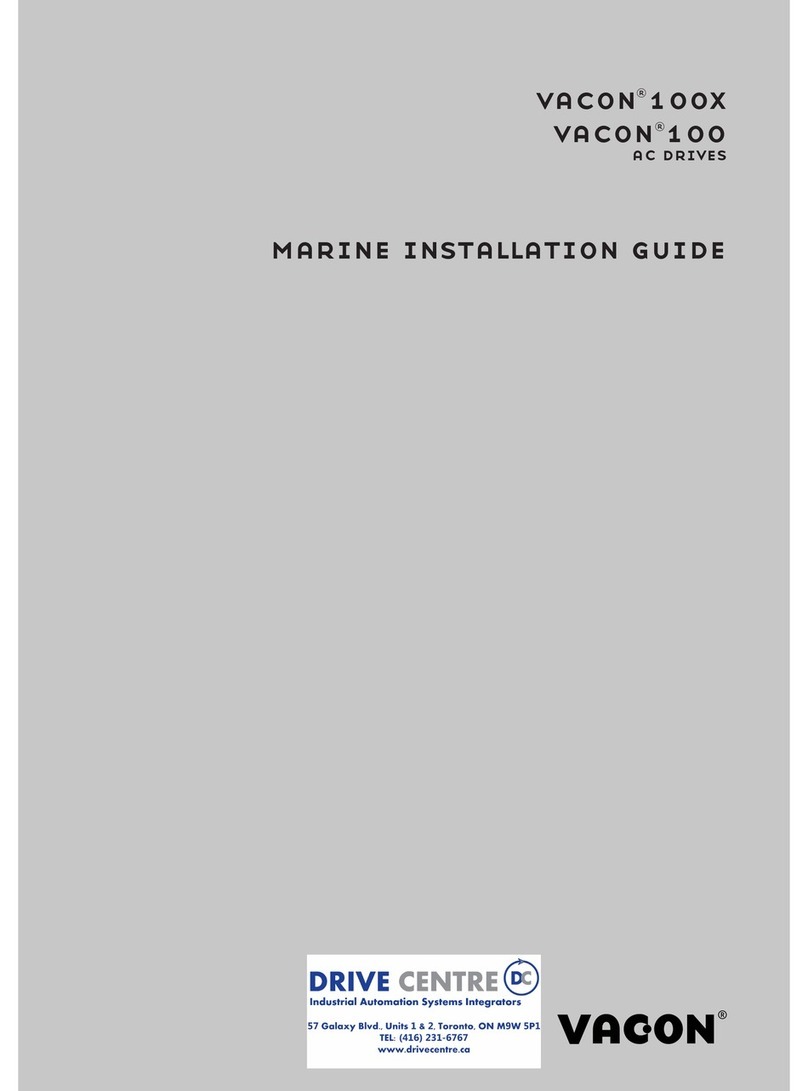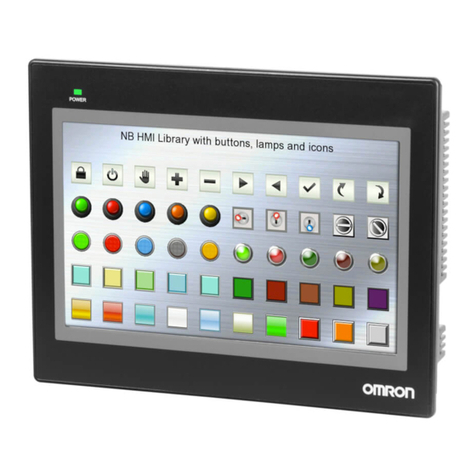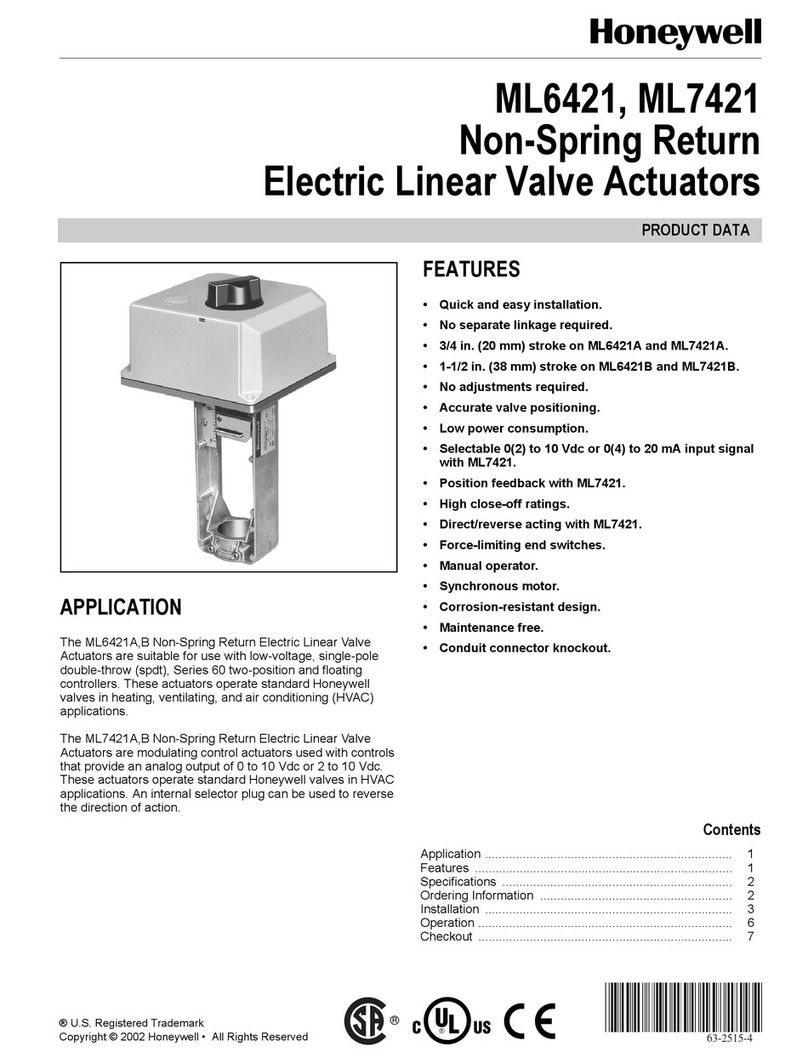Schwank ThermoControl Plus 4M Specification sheet

ThermoControl Plus 4M
Controller with four heating zones
Modulation or 2-stage control
(alternative: eight heating zones with 1-stage control)
Operating and
Installation Manual
Schwank Group
5285 Bradco Blvd., Mississauga, ON L4W 2A6
2 Schwank Way, Waynesboro, GA 30830
Tel.: 1-8 -446-3 2 Fax: 1-866-361-0523
www.schwankgroup.com
Version: v.2_ March 2021

- 2 -
Content:
1 INTRODUCTION ................................................................................................. 3
2 SAFETY .............................................................................................................. 4
3 Structure and Function ........................................................................................ 5
4 OPERATION ....................................................................................................... 6
4.1 Basic operational parameters........................................................................... 6
4.1.1 Further information ........................................................................................ 6
4.1.2 Selection of a heating zone ...........................................................................
4.1.3 Turning the selected zone on/off...................................................................
4.1.4 Special information on the default screen .....................................................
4.2 Display and change of day- and night time temperature .................................. 8
4.3. How to read and modify time and date............................................................ 9
4.4 Scheduling ..................................................................................................... 11
4.4.1 How to read program schedule ................................................................. 11
4.4.2 How to clear a on/off program ................................................................... 12
4.4.3 How to clear a schedule ............................................................................... 12
4.4.4 How to protect the schedule program .......................................................... 12
4.4.5 How to program the on/off commands ......................................................... 13
4.5 Vacation program ........................................................................................... 14
4.6 Manual operation
FIX
.................................................................................. 15
4. Button for system check mode ...................................................................... 15
5 SET UP THE OPERATING PARAMETERS ..................................................... 16
5.1 Enter the number of heating zones ................................................................ 16
5.2 Set up the parameters.................................................................................... 1
5.3 The Heat-up optimization ............................................................................... 19
5.4 COPY ............................................................................................................. 19
5.5 How to do a security save and how to reload all parameters: ........................ 20
6 INSTALLATION................................................................................................. 20
6.1 Important general instructions ........................................................................ 21
6.2 Sensor connections ........................................................................................ 21
6.3 Connection of the heaters .............................................................................. 21
6.3.1 Modulation outputs (2-10V) ......................................................................... 21
6.4 Wiring connections ......................................................................................... 22
6.5 Exhaust fan connection .................................................................................. 24
6.5.1 Air-proving contact inputs ............................................................................ 24
6.6 Alarm contact input......................................................................................... 24
6. Remote-Control ........................................................................................ 24
6.8 Signal input fault............................................................................................. 24
6.9. Temperature display ºF / ºC selection ........................................................... 25
6.10 Communication connection .......................................................................... 25
6.11 Common ERROR signal............................................................................... 26
TECHNICAL PARAMETERS ............................................................................ 2
8 APPENDIX ........................................................................................................ 28

- 3 -
1 ntroduction
The Schwank ThermoControl Plus 4M is suitable for the control of single or two-stage /
modulation gas-infrared heating systems.
Depending on the selected operation mode, the controller has 4 to 8 heating zones.
Please read this manual carefully before installing or using the control unit. Failure to follow the
manual and warnings will affect your warranty. They are also a prerequisite for a professional
installation and correct handling.
Please pay special attention to chapter 2 „Safety“.
The ThermoControl Plus 4M is designed to be used for industrial/commercial building heating
systems.
Schwank will not be held responsible for any damages whatsoever resulting from incorrect use.
The controller measures the room temperature and switches the heater on/off by relays.
The controller features different operating programs.
P1…P5: Single-stage, Two-stage and Modulating heaters.
Daytime heating period extension +h
Available as a special feature is the extension of the programmed heating period by a manually
operated button. This button can be installed parallel to the sensor. By pushing the button
(~1 sec.), the value of the programmed daytime temperature in the selected heating zone is
maintained for an additional time period. (Default is 1h, adjustable in the parameter menu)
Programmed temperature values and operating programs
The temperatures and operating programs of every single heating zone are independently
selectable.
- Daytime- , night time- or frost protection temperature , selected by a weekly
schedule
- Continuous daytime ( F X) night time, ( F X) or frost protection temperature ( F X).
- Vacation program: the controller is able to save eight vacation periods, which are programmed
according to the calendar.
Other Features:
– Four air-proving contact inputs
– Four 2-10V modulation outputs
– Illuminated display
– Selectable ºF / ºC temperature display
–
Button for system check mode
–
Real-time clock with calendar, including automatic summmer- / winter time correction
– Outdoor temperature sensor (OAS)
– Heat-up optimization: the heater starts/switches on earlier to ensure that the desired
temperature is achieved exactly at the programmed time.
–
Remote acess control
– Working-hour/time-counter at every relay output
– Error-relay: relay switches on in any case of error

- 4 -
2 Safety
nstallation details
This is a 24VAC Class 2 extra low
voltage temperature controller. Use
only Class 2 rated power supply. Do
not install on voltages higher than
30VAC.
Read all information in this manual
before installing or programming the
appliance. The electrical installation
and wiring must conform to local and
national building and electrical
standards. Check the electrical
equipment regularly. Defective wires
etc. must be replaced immediately.
Be sure that power routed to the
controller has been powered off
before beginning installation or
making any setting. Make sure that
nobody can connect appliance to the
power supply while you are working.
The Schwank ThermoControl Plus 4M
has to be mounted on/at a place,
where it’s not affected by vibrations
or shocks.
Please install the ThermoControl
Plus 4M ensuring conformity to the
wiring diagram.
Ensure that the controller and the
heater relays are connected by 16
AWG cable and controller and
sensor connected by a 18 AWG
cable.
nstall the room-temperature-
sensor between the radiation
area of two heaters at a height of
2.5 m. Therefore the controller
receives an optimal value of the
nominal temperature.
+If the controller is installed in a large
building or in a building with
extreme temperature differences
(temperature gradiants), you can
also measure average temperature,
connecting additional room-
temperature sensors for every
single heating zone control circuit.

- 5 -
3 Structure and Function
Front panel layout:
1. /O Main switch on / off
2. LCD Display: All functional- and operating-information is shown on the default screen
(picture above).The control unit switches back to the default screen, if no button is
pushed for more than one minute.
3. If you push the button or the button, the daytime or night time temperature
setpoint will be displayed immediately. By using the +/- buttons the values can be
modified.
4. + / - With these buttons the currently displayed value can be increased or decreased.
5. D SP „Display-button“: To change the displayed screen. This button also offers the ability
to switch back to the default screen immediately.
6. SEL „SELECT”: This button allows you to select a certain parameter out of every
parameter shown on the display. The chosen/selected parameter can be modified by
the +/- buttons.
7.
8.
FIX
9. PR
Clock-button: It can be used to display and modify time and date.
Push to switch between programmed and FIXed operation modes.
To check and modify the weekly schedule program in the displayed heating zone.
10. CLR „Clear-button“: To delete a switch-point or a complete schedule program.
11. Copy Push to copy time- and temperature programs.
12. ERROR The system-error light turns on for any kind of error. A blinking sign on the display
will provide information about the cause.
13. ZONE Push to switch between different heating zones.
14. Push to turn on/off the selected heating zone.
15. SERV CE „Maintenance”: If this sign appears, the system requires maintenance: please call
16.
service.
Push to program vacation operation mode.
17. Button for system check operation mode: all heating zones will operate with full
load.

- 6 -
4 Operation
4.1 Basic operational parameters
By starting the ThermoControl with the I/O switch an automatic display-test is activated. The
controller starts up with default settings. Afterwards the display jumps to the default screen,
which shows all the important operational information.
4.1.1 Further information
Actual control mode, in
this case: day
mode Present status of the heater:
full load
partial load (2-stage or Modulatingl)
heater is turned off
Measured temperature
in the room/zone
(18.2°C)
The exhaust fan is
working (optional)
1: Air-proving closed
1: Air-proving open
ID number of the
selected heating zone
ID number of relay outputs and sensor
inputs assigned to the currently selected
heating zone.
Outdoor temperature – value measured by OAS
outdoor temperature sensor only
Operation time counter: All stage relays have a
counters in two-stage control mode
Push the SEL button to
switch between the stage
counters. The shown data
cannot be modified, after
199999 hours the display
resets to zero.
The default screen gives all important operating data,
further information can be retrieved by pushing the
D SP button.
Value of the entered frost protection temperature .
The displayed value can be changed by pushing the
+/- buttons. Value range: +3 ... +20 °C / 3 ...68 ºF
Current level of heater output.
In one-stage operation it only shows 0% or 100%.

- -
4.1.2 Selection of a heating zone
4.1.3 Turning the selected zone on/off
If you want to stop heating a certain zone, push the button. The symbol will sign the
off-state of the zone. Measurement and display of zone temperature still works in a zone that is
turned off. You can turn the zone on again by pushing the button.
4.1.4 Special information on the default screen
The screen content, and adjustable
parameters belong to the selected
heating zone. The zone can be
selected by pushing the ZONE
button. After pushing the button, all
settings of the heating zone can be
adjusted and set.
During the optimized heat-up period, you will notice the
OPT symbol. The starting time of a specific zone is
determined by an algorithm. This way the controller
automaticaly adapts to environmental specifics like outdoor
temperature, heat-up performance, and possible structural
changes in the heating zone. The feature can only be
deactivated in the setup-menu. An OAS outdoor
temperature sensor is required for this feature.
While using the vacation-mode the sign will be marked.
To stop or modify the vacation program, please push the
button (chapter 4.5).
Option: After pushing the override button the day time
mode starts for a preset, adjustable time (0:00-24:00h;
default is 1h). At the same time the +h symbol will be
marked. This operation can be stopped by using the
FIX
button.
Night time mode has been selected remotely ( ? ). All
three operation modes ( 4 21 ) are possible, just like
in case of FIXed modes.

- 8 -
4.2 Display and change of day- and night time temperature
The desired temperature for every heating zone can be programmed separately.
Pushing the D SP button, (or automatically after
one minute, without pushing a button) the display
jumps back to the default screen.
The current day- or night
time temperatures can be
displayed, if you push the
or button.
The displayed values can be
modified by pushing the +/-
buttons.
All modifications are saved
immediately.
The temperature setpoint
values can be adjusted in
the following range:
+3…+35
°C / 3 ...95
º
F

- 9 -
4.3. How to read and modify time and date
To read and modify time and date, the button has to be pushed.
All heating zones have a separate program schedule. This function takes place in the digital
clock. At first the time is shown (in the picture: 14:03). Afterwards you have to use the button
again, to be able to change the year (2021), after pushing the button for the third time month and
day (in this case: 3 = March, 24) are displayed. „3 Day” stands for the third day of the
ongoing week, in other words: Wednesday. ( 1= Monday, etc.)
After using the button once more the display jumps back to the normal clock.
The display jumps to default screen, if you press the D SP button.
Setting the time
To change the time, the
SEL button has to be
pressed. At first the
minutes start to blink
(03), which can be
modified by using the
buttons +/-.
After pushing the SEL
button again, the hours
will start to blink. (14)
The hours can also be
changed with the +/-
buttons.
The setting of the time
can be finished by using
the button.
Afterwards the display
goes back to the year.
Remark: symbols or figures, which are framed are
blinking ones!

- 10 -
Setting the year
After the time has been modified, you have to set the right year, month and day as well.
Otherwise the automatic summer- / wintertime correction won’t work correctly.
Setting the month and day
To change the year, you have
to press the SEL button. The
last two figures will start to blink
(20), they can be modified with
the +/- buttons.
Afterwards the button has to
be pushed, and month and day
respectively will be shown on
the display. When the year has
been modified, the day of the
week might be changing,
according to the calendar (in
this case 3).
To change the setting you have
to press SEL. At first the month
(3) will start to blink, the setting
can be modified with +/-.
To change the day please push
the SEL button again. Now, the
day starts to blink (24). The day
can also be modified with the
buttons +/-.
Once more the day of the week
changes according to the
calendar (first from 3 to 6, then
from to ).
If the setting is completed push
D SP. After pushing the button,
the display switches back to the
default screen.

- 11 -
4.4 Timing
Every heating zone has an independent schedule program, which can be modified.
The time program is a series of different switching times or switching points. The
controller changes automatically from daytime , to night time or frost protection mode .
An on/off command can be described as:
- time (hour and minute)
- operation mode , or , which will start at this time
- day of the week, or couple of days, when the on/off command should be active
(1 = Monday, 2 = Tuesday …… =Sunday)
- number of on/off command (max. 19 times in one program)
4.4.1 How to read a time program
To see the time program in the selected zone push the PR button.
Then display will jump to the first programmed on/off command. When press the PR button
repeatedly the stored on/off command will appear one by one. Over the symbol the number of
the on/off command can be seen, on the upper part of the display the " 1 2 3 4 5 Day" informs
that on what days of the week ( 1= Monday…) will this on/off function be active. With a
few presses on the PR button you can see the full weekly heating program. Two
examples can be seen here:
At the on/off (7:00) daytime
mode heating is
started. Then at time point 2 (
17:30) the night time mode
heating begins. As
these two points are valid on
the first five days of the week
( 1 2 3 4 5 Day) and there
are no other programmed
points for the last two days (6
7) the whole weekly program
is described with these two
command points.
In the next example this
program is extended with two
additional on/ff
commands : on Saturday ( 6
Day) at the time 3 (8:00)
day mode heating is started,
then at time point 4 (12:45)
the frost protection mode
begins. This mode will be
active until the next on/off
command(1) that is on Monday.
When you first press the PR
button: for a short time the
display will show the number
of free on/off command
locations (here:1 free points).

4.4.2 How to clear a switching point
4.4.4 How to protect the program schedule
The function of the program schedule is based on the clock and calendar data.
The clock is supplied by a battery (1,5 V AA). A warning signal shows, when the battery has
to be changed. The exact time and date won’t get lost while the battery is getting changed (for 2
minutes).
In case the control unit has not been used for a long time, including a complete discharge of the
batteries, you will have to check if time and date are still correct after the change of the battery,
to avoid problems.
The saved on/off command are independent of the battery charge, because the program
is saved on a secured EEPROM-
memory . Thus time programs cannot get lost as a consequence
of a battery change or in the case of any other mistake.
- 12 -
If you want to clear an on/off
command, you have to push
and hold the CLR button. The
symbol CLR will blink on the
display, so that you are warned
you are going to clear a on/
off command,. If the CLR
button is released immediately
the cancellation will be stopped.
If the cancellation is completed,
horizontal lines are visible.
Afterwards the new number of
free on/off commands are
displayed.
The ID number of an on/off command, is not fixed. If an on/off
command, is deleted the numbers of the remaining command will be assigned
again, thus there is no chance of holes in the time program.
4.4.3 How to clear a whole program schedule
To clear a whole on/off
schedule, you have to push
and hold the
CLR button while the number of
free spaces are shown in the
display (FrEE).
The symbol CLR will start to
blink, to warn you. If the button
is released immediately the
cancellation of the program
will be stopped.
The cancellation is completed, if
horizontal lines become
visible. That is followed by
the new number of free spaces (
19).

- 13 -
4.4.5 How to program the switching points
In this example we program the following circumstance: The day
temperature should start every morning at :35 from Monday
till Friday. First of all we are searching for a free on/off point by
using the PR button. Then we press the SEL button to modify the
new data. The same procedure can be used for existing son/off
points.
At first the type of
temperature starts to blink.
Now you are able to chose
between and
button by using the +/-
buttons.
Now you can select
the day program with
the SEL button. Then
the whole week
appears: 123456
Pressing +/- you
are able to select
different day groups
or only single days
(1=Monday).
Afterwards you can modify
the hour by pushing the SEL
button (12). The requested
time ( ) can be set with +/-.
After you select the minutes
with SEL (00), the requested
time (35) can be set with +/-.
Finally the PR button has to
be pushed. Afterwards the
display switches to the next
free switching point.
It is not possible to program two different on/off
points with the same time parameter. In case of a saving mistake of two on/off points
for the same time, the time of the last programmed command will be corrected by one
minute.
In this case a new on/off
point was programmed with a
time parameter of :35.
Unfortunately this time
parameter was used already in
on/off
command 3. Thus the time
changes automatically to :36.

- 14 -
4.5 Vacation program
The controller gives you the opportunity to program 8 vacation periods. Beginning and ending of
the vacation is displayed with exact data (year, month, day). The programs can be changed or
stopped anytime.
During the vacation program the frost protection temperature will be maintained.
To program the holiday periods, push the
button.
At first the number of the vacation program HOL 1 (vacation 1) appears. The number above t
he vacation number shows which program is activated. A programmed vacation period
starts
automatically at the programmed date. With the SEL button you are able to start or stop the
programmed vacation period. If the program is switched off (program number does not appear) it
won’t start, a running program would be shut down respectively. By using +/- you are able to
choose one of the 8 holiday programs.
. If a
The vacation program starts in all heating zones, which are working in automatic mode
zone is working on a fixed mode (FIX), the vacation program has no effect there.
If you push the
button again, the start of the holiday
period can be modified(A): by pressing +/- you can set
the year, month and day.
The holiday program starts at 0.00 o’clock on the
desired date.
After you have modified the start (A), you will have to
set up the end (B) of the holiday period. To fix the date
please use the +/- button. The completed program
ends at 0.00 o’clock on programmed day.
Press button to finish programming, the display
switches back to HOL.1. Now you can select the next
vacation program and start its modification,
otherwise you can get back to the default screen by p
ushing the D SP button.
It is possible, that the ERR symbol appears, while you
are programming the holidays:
- if start date A is later than the programmed end of the
vacation period B
- if the end of the period B is earlier than the present
date.
A program, that indicates one of these problems, would
n’t start.
If all errors are eliminated the ERR –symbol disappears.

- 15 -
4.6 Manual operation
FIX
If you use the
FIX
button, you are able to select different operating modes.
4.7 Button for chimney-sweep mode
To change the F X
mode you have to
push the
FIX
button.
Press D SP, if the desired operation mode
appears (for example: continuous F X
mode). The control unit switches back to the
default screen and the selected mode is
activated.
night-temperature mode
day-temperature mode
frost protection temperature
By pushing the button the heater runs with full
power independent of the current room temperature.
You can switch back to the base display mode by
pushing this button again.
Push
FIX
to get back to the default screen.
System check mode activated remotely (
?
).
To turn off System check mode, push the
button.

- 16 -
5 Set up the operating parameters
The setup parameters can be modified from the front panel. To modify the
parameters you have to have technical knowledge, otherwise proper operation can not
be guaranteed. Inside the controller there is a sliding switch to avoid unwanted
functional changes, thus
parameters can be locked. The switch is located in the upper inside of the control unit. Permit
the setup: „ON”, avoid the setup: „OFF”.
Before you open the control unit, please read the important notes in chapter 2! The
„setup”-switch as well as the selection of the program P1 and P2 may only be carried out
after the power routed to the controller has been cut off.
The main operation program can be selected inside the controller unit(P1, P2, P3, P4, P5).
A small “jumper“ has to be placed in the correct position. Only one program can be chosen at
any given time. Please be careful by choosing the right electrical connection for the desired
program!
In case of changing the application program(P1, P2, P3, P4, P5) all parameters switch back to
the default settings (chapter 5.1 and 5.2) !
P1 - Eight heating zones, single-stage
P2…P5 – Four to seven zones, single-, two-stage or modulation control
5.1 Enter the number of heating zones
The controller is able to manage four to eight control zones, depending on the chosen operation
program. In the following example we are fixing the actual number of control zones.
Get back to the default screen by pushing the D SP button.
Hold the ZONE button for about 3
seconds. The number of available
heating zones appears on the
screen (for example.: 1-8: eight
heating zones). The desired
number of heating zones can be
selected if you push +/- (1- ).

- 1 -
5.2 Set up the parameters
To set up the parameters please hold
the D SP button for about 3 seconds.
The „Par” symbol appears for a short
time. The parameters can be
selected with the SEL button.
Threshold value for second-stage:
0.5...3.0 °C / 1.0...5.5 ºF. Only in two-stage mode; in single-
stage mode: --.--
Integration time: 10…99 minutes Only in two-stage or
modulation mode, in single-stage mode, or in off-state
(--.--) appears. Setting it lower than 10 will result in off-state
of integration.
Hysteresis , can be activated by
0.2…2.0 °C / 0.4...3.6 ºF
Sensor correction: if the sensor could not be mounted at an
optimal place, the measured temperature can be offset:
-9.9..+10.0 °C / -9.9..+10.0 ºF
t1: After starting the heater, it runs with full power until it
stops at the programmed time, in this case: 0…5 minute.
t2: For the displayed time, the heater stops completely
(5..60 Sec). It only appears, if the t1 is not equal to zero.
Ability of a restart:
t3: The heater starts with full load for 1 minute, afterwards
the controller switches to the regular mode (0: off). It does
not appear unless the two-stage control is selected.
Proportional range: 1.5...10.0 °C / 2. ...18.0 ºF.
The modulated output is spread across this range.
Only in modulation mode; in single-stage mode: --.--.
Output precentage of the heater in first-stage.
Only effects the displayed value.
In single-stage mode (--.--) appears.

- 18 -
Minimal operation time of the heater. ( 0...15 min)
Exhaust fan follow-up-time :
After the heating zones have been switched off, the exhaust
fan continues to run for a preset time. From 0 up to 60
minutes can be programmed (it appears only in the ”AUto”
ventilation mode).
The Heat-up optimization can be switched on (AUto) or
off (OFF). The effective warm up time is shown.
Automatic switch from summer time
to wintertime (+/- 1h).
This function can be activated (AUto)
and deactivated (OFF).
If a communication module is integrated into the controller, other parameters will follow.
’OFF’: the exhaust fan is switched off (also the symbol
doesn’t appear).
’AUto’: exhaust fan and air-proving contact in use.
Programmable time for the override button +h
(0:00-24:00)
The illumination of the display can be
programmed: 1…9 minutes, switched
on (ON) or switched off (OFF).
Feature selection of the contact input
no. 2- 3:
: remote contact
RES-ERR: signal input - Error

- 19 -
5.3 The Heat-up optimization
The Heat-up optimization is only operational if an OAS sensor is connected to the controller.
The program works automatically and doesn’t need to be adjusted. The Heat-up optimization
follows an easy principal: the controller switches on the heater earlier than it is programmed,
so the desired temperature is achieved at the favoured time. Temperature differences and the
current outside temperature are integrated in the calculation for the heat-up time. The control-
unit incorporates the heating characteristics of the building and adjusts the starting point of the
heat-up time to be precise. Every heating zone has a separate, optimized heat-up time.
5.4 COPY
The COPY button offers you the opportunity to copy all parameters of a certain zone or the
complete time program and insert it into the program of one or many other zones.
To copy parameters hold DSP
(approx. 3 sec., chapter 5.2).
To copy time programs use the PR button
(chapter. 4.4.1).
To exemplify the procedure, we copy the data of
Zone 1.
ZONE signal and number of Zone 2 start to blink. „COPY“
appears on the screen to indicate the copy mode. Push
COPY to paste the data of Zone 2.
The data of Zone 1 are now copied into Zone 2, The
numeric 2 is indicating the completion of the copy process.
Now you can continue to copy to other Zones by selecting
Zone 3 to Zone 8 using the SEL button.
To finish the copying of the parameters you have to press
D SP, while you have to use the PR-button to finish the
copying of time programs.

- 20 -
Door
Lock Screw
Upper part
Lower part
Bracket
244
265
180
205
25
140
96
5.5 How to do a security save and how to reload all parameters:
The Schwank-service technician can save all operational parameters as a package on a
storage memory. In case of unintentional parameter changes, and functionality problems, the
stored parameters can be restored. It is also possible to reload the default settings.
6 nstallation
Press CLR and +
simultaneously. The „SAVE”
symbol will appear on the
display. Now push D SP, the
display will start to blink, the
parameters are saved,
afterwards the display switches
back to the default screen.
If you press CLR and SEL simultaneously, the „LOAd”
symbol appears on the display. Then press the D SP
button and the parameters, that were saved by the
Schwank-service technician, will start to reload. Switch
from „LOAd” to „FACt“, by using the +/- button. If „FACt”
appears on the display, push the D SP button and the
default parameters are restored.
Table of contents
Other Schwank Controllers manuals

